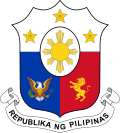| |||||||||||||||||||||||||||||
All 93 seats in the House of Representatives of the Philippines 47 seats needed for a majority | |||||||||||||||||||||||||||||
|---|---|---|---|---|---|---|---|---|---|---|---|---|---|---|---|---|---|---|---|---|---|---|---|---|---|---|---|---|---|
| |||||||||||||||||||||||||||||
| |||||||||||||||||||||||||||||
 |
|---|
Elections for the members of the House of Representatives were held on June 6, 1922, pursuant to the Philippine Organic Act of 1902, which prescribed holding elections every three years. The ruling Nacionalista Party was split into the Colectivista (headed by Senate President Manuel L. Quezon) and the Unipersonalista (headed by outgoing Cebu–2nd Representative and former House Speaker Sergio Osmeña) factions. [1] If combined, both blocs formed the largest party grouping in the House, with 64 of the 93 members. The Democrata Party emerged as the strongest opposition party since then Progresistas of the 1910s, winning 25 seats. The elected representatives would serve in the 6th Philippine Legislature from 1922 to 1925.


